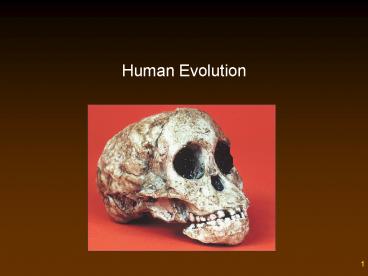Human Evolution PowerPoint PPT Presentation
Title: Human Evolution
1
- Human Evolution
2
Outline
- Origin of Life
- Biological Evolution
- Common Descent
- Natural Selection
- Primates
- Human Evolution
- Evolution of Modern Humans
3
Origin of Life
- The Primitive Earth.
- Theorized early primitive atmosphere consisted
mostly of water vapor, nitrogen, and carbon
dioxide, with small amounts of hydrogen and
carbon monoxide. - Little, if any, free oxygen.
4
Origin of Life
- Small Organic Molecules.
- Primitive gases may have reacted with one another
and produced small organic compounds such as
nucleotides and amino acids. - Macromolecules.
- RNA-first hypothesis.
- Protein-first hypothesis.
5
Origin of Life
- Protocell.
- A protocell, which could carry on metabolism but
not reproduce, may have formed when lipids and
microspheres formed a lipid-protein membrane. - A True Cell.
- A true cell can reproduce.
- Modern cells replicate before cell division
occurs.
6
Biological Evolution
- First true cells were prokaryotic.
- Eukaryotic cells evolved later, followed by
multicellularity and other kingdoms. - Biological evolution is a change in life forms
that has taken place in the past and will take
place in the future. - Adaptation is a characteristic that makes an
organism able to survive and reproduce in an
environment.
7
Common Descent
- Charles Darwin first formulated the theory of
evolution and gathered evidence that life forms
change over time and distance. - Lines of evidence.
- Fossil evidence.
- Biogeographical evidence.
- Anatomical evidence.
- Homology vs. Analogy.
- Biochemical evidence.
8
Natural Selection
- Natural selection is a process by which a species
becomes adapted to its environment. - Contrasted to Lamarcks teleological explanation.
- Critical elements of natural selection.
- Variation.
- Struggle for existence.
- Survival of the fittest.
- Adaptation.
9
Humans Are Primates
- Biologists classify organisms according to their
hypothesized evolutionary relatedness. - Binomial name lists genus and species.
- Characteristics of primates.
- Opposable thumb.
- Well-developed brain.
- Nails.
- Single birth.
- Extended parental care.
- Emphasis on learned behavior.
10
Humans Are Primates
- Molecular data have been used to determine the
date of the split between hominids and apes. - When two lines of descent first split, the genes
and proteins of the two lineages are nearly
identical. - As time goes by each lineage accumulates genetic
changes.
11
Humans Are Primates
- Many genetic changes can be used as a molecular
clock to indicate relatedness of two groups. - Evolution of bipedalism is believed to be the
distinctive feature that separates hominids from
apes.
12
Primate Evolutionary Tree
13
Evolution of Australopithecines
- Hominid line of descent begins in earnest with
the australopithecines. - Evolved and diversified in Africa.
- It is unknown which australopithecine is
ancestral to early Homo.
14
Evolution of Humans
- Homo habilis dates between 2.0 and 1.9 mya and
may be ancestral to modern humans. - Teeth evidence indicates omnivory.
- Animal bone evidence indicates use of tools to
strip meat. - Skulls of early Homos suggest portions of the
brain associated with speech areas were enlarged.
15
Human Evolution
16
Homo erectus
- Homo erectus and like fossils are found in
Africa, Asia, and Europe, and date between 1.9
and 0.3 mya. - Compared to H. habilis, H. erectus had a larger
brain and a flatter face. - H. erectus was first hominid to use fire, and
fashioned more advanced tools than early Homos.
17
Homo erectus
18
Evolution of Modern Humans
- Multiregional continuity hypothesis states that
Homo sapiens evolved in several different
locations. - Opponents suggest out-of-Africa hypothesis.
19
Evolution of Modern Humans
20
Neanderthals
- First Neanderthals were discovered in Germanys
Neander Valley, and date back 200,000 years ago. - Evidence of cultural advancement.
- According to out-of-Africa hypothesis,
Neanderthals were eventually supplanted by modern
humans.
21
Cro-Magnons
- Cro-Magnons are the oldest fossils to be
designated Homo sapiens. - Named after fossil location in France.
- Hunted cooperatively, and may have been first to
have language. - Advanced culture included art.
22
Neanderthals and Cro-Magnons
23
We Are One Species
- Human beings are all classified as Homo sapiens.
- DNA variation between races is the same level as
DNA variation within the same race. - Differences in body shape represent adaptations
to temperature and environmental conditions.
24
Review
- Origin of Life
- Biological Evolution
- Common Descent
- Natural Selection
- Primates
- Human Evolution
- Evolution of Modern Humans
25
(No Transcript)

